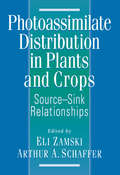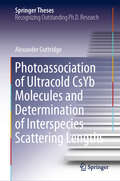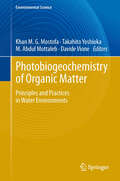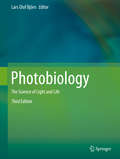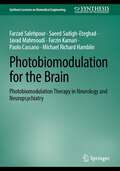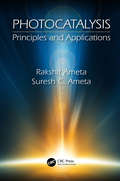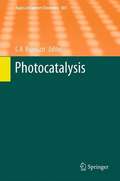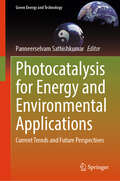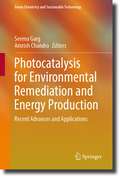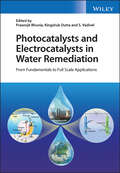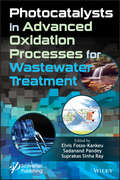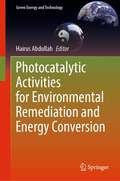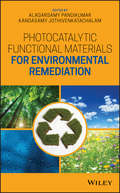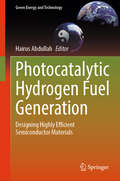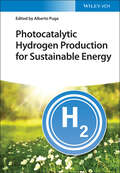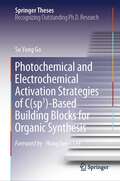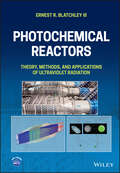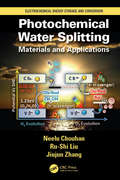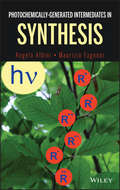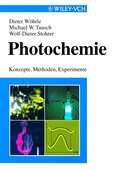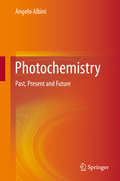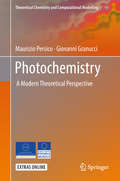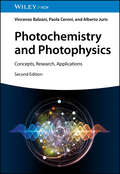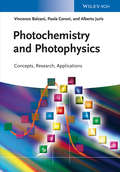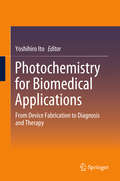- Table View
- List View
Photoassimilate Distribution Plants and Crops Source-Sink Relationships: Source--sink Relationships (Books in Soils, Plants, and the Environment)
by ZamskiAdopting an interdisciplinary approach to the study of photoassimilate partitioning and source-sink relationhips, this work details the major aspects of source-sink physiology and metabolism, the integration of individual components and photoassimilate partitioning, and the whole plant source-sink relationships in 16 agriculturally important crops. The work examines in detail the components of carbon partitioning, such as ecology, photosynthesis, loading, transport and anatomy, and discusses the impact of genetic, environmental and agrotechnical factors on the parts of whole plant source-link physiology.
Photoassociation of Ultracold CsYb Molecules and Determination of Interspecies Scattering Lengths (Springer Theses)
by Alexander GuttridgeThis thesis lays the groundwork for producing a new class of ultracold molecule by associating an alkali-metal atom and a closed-shell alkaline-earth-like atom, specifically Cs and Yb. Such molecules exhibit both a magnetic dipole moment and an electric dipole moment in their ground state. This extra degree of freedom opens up new avenues of research including the study of exotic states of matter, the shielding of molecular collisions and the simulation of lattice spin models.In detail, the thesis reports the first and only ultracold mixture of Cs and Yb in the world, giving details of the methods used to cool such contrasting atomic species together. Using sensitive two-colour photoassociation measurements to measure the binding energies of the near-threshold CsYb molecular levels in the electronic ground state has allowed the previously unknown scattering lengths to be accurately determined for all the Cs–Yb isotopic combinations. As part of this work, the one-photon photoassociation of ultracold Cs*Yb is also studied, yielding useful information on the excited-state potential. Knowledge of the scattering lengths enables a strategy to be devised to cool both species to quantum degeneracy and, crucially, determines the positions of interspecies Feshbach resonances required for efficient association of ground-state CsYb molecules. With these results, the prospect of bringing a new molecule into the ultracold regime has become considerably closer.
Photobiogeochemistry of Organic Matter
by Davide Vione Khan M.G. Mostofa Takahito Yoshioka Abdul MottalebPhotoinduced processes, caused by natural sunlight, are key functions for sustaining all living organisms through production and transformation of organic matter (OM) in the biosphere. Production of hydrogen peroxide (H2O2) from OM is a primary step of photoinduced processes, because H2O2 acts as strong reductant and oxidant. It is potentially important in many aquatic reactions, also in association with photosynthesis. Allochthonous and autochthonous dissolved organic matter (DOM) can be involved into several photoinduced or biological processes. DOM subsequently undergoes several physical, chemical, photoinduced and biological processes, which can be affected by global warming. This book is uniquely structured to overview some vital issues, such as: DOM; H2O2 and ROOH; HO*; Degradation of DOM; CDOM, FDOM; Photosynthesis; Chlorophyll; Metal complexation, and Global warming, as well as their mutual interrelationships, based on updated scientific results.
Photobiology
by Lars Olof BjörnThe new edition of this authoritative text provides an interdisciplinary treatise of all aspects of the interactions between light and the living world. It starts with a description of the physics of light, and how to deal with it in experiments and observations. The phenomena described in the rest of the book covers all organisms: how light is used by organisms for obtaining energy for life processes, for gathering information about the environment, and for communicating with others of the same or other species. The book also describes "bad" effects of light in causing disease or contributing to formation of environmental toxins. New techniques used by scientists to investigate life processes using light are also explored in the volume. Written by experts in the field, Photobiology: The Science of Life and Light, 3e is a valuable and accessible resource for both advanced undergraduates and established researchers.
Photobiomodulation for the Brain: Photobiomodulation Therapy in Neurology and Neuropsychiatry (Synthesis Lectures on Biomedical Engineering)
by Farzad Salehpour Saeed Sadigh-Eteghad Javad Mahmoudi Farzin Kamari Paolo Cassano Michael Richard HamblinPhotobiomodulation for the Brain: Photobiomodulation Therapy in Neurology and Neuropsychiatry collects scientific evidence covering a broad range of topics, including the optimum dosimetry, treatment regimens, irradiation sites, irradiance and fluence, treatment times, and possible side effects of this neuromodulation therapy. Over the past two decades, brain photobiomodulation (PBM) therapy has been introduced as an innovative modality for stimulating neural activity to improve brain function and is predicted to become a promising strategy for neurorehabilitation in the coming years. This book introduces PBM therapy to the worldwide medical community, providing worthwhile scientific insights and promoting the acceptance of this field among neurologists, psychiatrists, neurorehabilitation practitioners, and physiotherapists, as well as neuroscience clinicians and researchers. From a physics point of view, scientists in the photonics, medical physics, and light-dosimetry fields will also benefit from the book.
Photocatalysis: Principles and Applications
by Rakshit Ameta Suresh C. AmetaPhotocatalysis, reactions carried out in the presence of a semiconductor and light, is rapidly becoming one of the most active areas of chemical research, with applications in areas such as electrochemistry, medicine, and environmental chemistry, Photocatalysis: Principles and Applications stresses the development of various types of photocatalytic semiconductors, including binary, ternary, quaternary, and composite, and their modifications by metallization, sensitization, and doping to enhance their photocatalytic activities. In addition to describing the principles and mechanisms of photocatalysis, it also discusses other possible applications of photocatalysis such as use as antifouling agents, controlling air pollution by degrading contaminants present in the environment, self-cleaning of glasses and tiles in the presence of light/artificial light, green composites, wastewater treatment, hydrogen generation, and inactivation of microorganisms. The book also describes medical applications and summarizes efforts in the field of photosplitting of water as a newer energy source and photoreduction of carbon dioxide for providing synthetic fuels and also a step towards mimicking photosynthesis. Introduces the basic principle of photocatalysis. Provides an overview of the types of semiconductors, their immobilization, and modifications to make them more active. Gives possible applications of photocatalysis in wastewater treatment and strategy to combat against different kinds of pollutions like water, air, and soil. Summarizes efforts in the field of photosplitting of water as a newer energy source and photoreduction of carbon dioxide for providing synthetic fuels and as a step towards mimicking photosynthesis. Discusses inactivation of different kinds of microorganisms. Covers medical applications. Features Introduces the basic principle of photocatalysis. Provides an overview of the types of semiconductors, their immobilization, and modifications to make them more active. Gives possible applications of photocatalysis in wastewater treatment and strategy to combat against different kinds of pollutions like water, air, and soil. Summarizes efforts in the field of photosplitting of water as a newer energy source and photoreduction of carbon dioxide for providing synthetic fuels and as a step towards mimicking photosynthesis. Discusses inactivation of different kinds of microorganisms. Covers medical applications.
Photocatalysis
by Carlo Alberto BignozziMetal Oxide Photoanodes for Water Splitting, by J. Augustynski, B. D. Alexander and R. Solarska; Hydrogen Production with Nanostructured and Sensitized Metal Oxides , by Stefano Caramori, Vito Cristino, Laura Meda, Roberto Argazzi and Carlo Alberto Bignozzi; Surface Nanostructures in Photocatalysts for Visible-Light-Driven Water Splitting, by Kazuhiko Maeda and Kazunari Domen; Artificial Photosynthesis Challenges: Water Oxidation at Nanostructured Interfaces, by Mauro Carraro, Andrea Sartorel, Francesca Maria Toma, Fausto Puntoriero, Franco Scandola, Sebastiano Campagna, Maurizio Prato and Marcella Bonchio; Photocatalytic Reduction of CO2: From Molecules to Semiconductors, by Tatsuto Yui, Yusuke Tamaki, Keita Sekizawa and Osamu Ishitani; Design of Heterogeneous Photocatalysts Based on Metal Oxides to Control the Selectivity of Chemical Reactions, by Andrea Maldotti and Alessandra Molinari;
Photocatalysis for Energy and Environmental Applications: Current Trends and Future Perspectives (Green Energy and Technology)
by Panneerselvam SathishkumarThis book presents the existing photocatalytic reactor design and the future developments and the progress needed for both solar light-driven hydrogen generation and environmental purification. The chapters discuss the renewable and commercial aspects of translucent polymer-linked heterojunction nanocomposites as visible light-responsive photocatalysts. Relevant to these areas, the field of growing interest in black-TiO2, perovskites, MXenes and their numerous applications are presented. The framework, structural features and the need of mesocrystals for solar light-driven photocatalysis are also included. The book also discusses the additional features of green chemistry-based synthesis of nanomaterials in order to reduce any secondary pollution that may be released in the environment due to unsafe disposal of solvents. In addition, the importance of bismuth-based nanophotocatalysts towards energy and environmental applications and their future development as alternative photocatalysts for the prevailing nanomaterials are presented. The book also touches upon the idea to generate green fuel hydrogen through photocatalytic and photoelectrochemical techniques. Overall the book highlights contemporary developments in the last decade, the future perspectives of photocatalysis and its application towards energy and environment.
Photocatalysis for Environmental Remediation and Energy Production: Recent Advances and Applications (Green Chemistry and Sustainable Technology)
by Seema Garg Amrish ChandraThis book explores the modification of various synthesis processes to enhance the photocatalytic activity in varied applications in the fields of environmental remediation and energy production. It outlines the enhancement of photocatalytic activity via alloys synthesis, thin film coatings, electro-spun nanofibers and 3D printed photocatalysts. The book further states the diverse applications of materials for degrading organic pollutants and airborne pathogens, improving indoor air quality and as a potential antimicrobial agent. The application of photocatalysts in green organic synthesis, biomedical field and in hydrogen evolution are also presented in the book. It covers theoretical studies of photocatalytic material and conversion of CO2 to value added chemical feed stocks. The book is of relevance to researchers in academia and industry alike in the fields of material science, environmental science & technology, photocatalytic applications and in energy generation and conversion.
Photocatalysts and Electrocatalysts in Water Remediation: From Fundamentals to Full Scale Applications
by Dr Prasenjit Bhunia Dr Kingshuk Dutta Dr S. VadivelPhotocatalysts and Electrocatalysts in Water Remediation Comprehensive resource describing the fundamentals, synthesis, and commercial applications of photocatalysts and electrocatalysts in water decontamination Photocatalysts and Electrocatalysts in Water Remediation introduces the fundamentals of both photo- and electro-catalysts and highlights the potentials of photo- and electro-catalysis towards water decontamination, covering strategies to improve photo- and electro-catalytic efficacies, functions of photo- and electro-catalysts and involved chemical reactions, and challenges and recent developments in the field, with additional discussion of both lab-scale and commercial-scale materials and processes. As a forward-thinking resource, the text also discusses the scope of further research on photo-, electro- and electrophoto-catalysts. Edited by three highly qualified professionals, with significant experience in the field, the text is further enriched with critically analyzed and expertly opined contributions from several well-known researchers around the world. In Photocatalysts and Electrocatalysts in Water Remediation, readers can expect to find information on: Fundamentals and functional mechanisms of photocatalysis in water treatment, and different synthetic routes and band gap engineering of photocatalysts Photocatalytic decontamination of organic pollutants from water and photocatalytic removal of heavy metal ions from water Smart photocatalysts in water remediation Fundamentals and functional mechanisms of electrocatalysis in water treatment Electrocatalytic degradation of organic pollutants and removal of heavy metal ions from water Different synthetic routes of electrocatalysts and fabrication of electrodes and combined electro-photocatalytic techniques in water remediation Photocatalysts and Electrocatalysts in Water Remediation serves as one of the most comprehensive and authoritative resources that has ever been published in this field and is a thoroughly complete source of information on the subject for researchers across a myriad of disciplines along with water industry professionals.
Photocatalysts in Advanced Oxidation Processes for Wastewater Treatment
by Elvis Fosso-Kankeu Sadanand Pandey Suprakas Sinha RayPhotocatalysts in Advanced Oxidation Processes for Wastewater Treatment comprehensively covers a range of topics aiming to promote the implementation of photocatalysis at large scale through provision of facile and green methods for catalysts synthesis and elucidation of pollutants degradation mechanisms. This book is divided into two main parts namely “Synthesis of effective photocatalysts” (Part I) and “Mechanisms of the photocatalytic degradation of various pollutants” (Part II). The first part focuses on the exploration of various strategies to synthesize sustainable and effective photocatalysts. The second part of the book provides an insights into the photocatalytic degradation mechanisms and pathways under ultraviolet and visible light irradiation, as well as the challenges faced by this technology and its future prospects.
Photocatalytic Activities for Environmental Remediation and Energy Conversion (Green Energy and Technology)
by Hairus AbdullahThis book highlights sustainable methods with photocatalytic activities to remediate environment and for energy conversion. The related photocatalytic materials are discussed in detail. Some significant photocatalytic applications in degrading industrial pollutants that include different organic dyes, purifying the polluted air, converting CO2 to alcohol fuels, storing energy from sunlight as ammonia by converting N2 to NH3, and splitting water by optimizing the oxygen evolution process are thoroughly elucidated. The chapters introduce the necessary materials and results, leading to a better conceptualization in order to work in the field of photocatalysis. Some related perspectives and outlooks are discussed in the last chapter for possible future developments.
Photocatalytic Functional Materials for Environmental Remediation
by Alagarsamy Pandikumar Kandasamy JothivenkatachalamA comprehensive volume on photocatalytic functional materials for environmental remediation As the need for removing large amounts of pollution and contamination in air, soil, and water grows, emerging technologies in the field of environmental remediation are of increasing importance. The use of photocatalysis—a green technology with enormous potential to resolve the issues related to environmental pollution—breaks down toxic organic compounds to mineralized products such as carbon dioxide and water. Due to their high performance, ease of fabrication, long-term stability, and low manufacturing costs, photofunctional materials constructed from nanocomposite materials hold great potential for environmental remediation. Photocatalytic Functional Materials for Environmental Remediation examines the development of high performance photofunctional materials for the treatment of environmental pollutants. This timely volume assembles and reviews a broad range of ideas from leading experts in fields of chemistry, physics, nanotechnology, materials science, and engineering. Precise, up-to-date chapters cover both the fundamentals and applications of photocatalytic functional materials. Semiconductor-metal nanocomposites, layered double hydroxides, metal-organic frameworks, polymer nanocomposites, and other photofunctional materials are examined in applications such as carbon dioxide reduction and organic pollutant degradation. Providing interdisciplinary focus to green technology materials for the treatment of environmental pollutants, this important work: Provides comprehensive coverage of various photocatalytic materials for environmental remediation useful for researchers and developers Encompasses both fundamental concepts and applied technology in the field Focuses on novel design and application of photocatalytic materials used for the removal of environmental contaminates and pollution Offers in-depth examination of highly topical green-technology solutions Presents an interdisciplinary approach to environmental remediation Photocatalytic Functional Materials for Environmental Remediation is a vital resource for researchers, engineers, and graduate students in the multi-disciplinary areas of chemistry, physics, nanotechnology, environmental science, materials science, and engineering related to photocatalytic environmental remediation.
Photocatalytic Hydrogen Fuel Generation: Designing Highly Efficient Semiconductor Materials (Green Energy and Technology)
by Hairus AbdullahThis book highlights crucial parameters and strategies in photocatalytic water splitting. The process utilizes light energy to drive the separation of water into hydrogen and oxygen with the help of a photocatalyst. The efficiency and performance of catalytic activities are determined by various parameters supported by material characterizations. Commonly, the catalytic performances in visible-light photocatalytic water splitting are governed by bandgap energy, surface area, crystal structure, charge carrier dynamics, catalyst loading, cocatalyst, pH of solution, and reaction temperatures. However, covering all the requirements to obtain a highly efficient catalytic activity is an impossible task. Some recent strategies with promising results have been explored to improve and optimize the catalytic properties. In addition, various techniques for catalytic material characterizations, such as XRD, SEM, TEM, XPS, XANES, EXALFS, TRPL, TPC, EIS, and CV analysis, are also discussed. Finally, some related perspectives and outlook are discussed for future development.
Photocatalytic Hydrogen Production for Sustainable Energy
by Alberto PugaPhotocatalytic Hydrogen Production for Sustainable Energy A complete discussion of photocatalytic hydrogen production, including water splitting, biomass or waste valorization, solar reactors, photoelectrochemical technologies, and more In Photocatalytic Hydrogen Production for Sustainable Energy, distinguished researcher Dr. Alberto Puga delivers a comprehensive exploration of photocatalytic hydrogen production. In the book, readers will find explanations of why and how this technology is called to have a significant impact on cleaner and sustainable production of fuels and find a valuable source of information on the mechanisms of light harvesting and the chemical transformations occurring in these processes. The book explains the technical and engineering approaches currently being used in photocatalytic hydrogen production, as well as approaches that may be used in the future for both commercial and research purposes. A fulsome approach to the subject, covering everything from fundamental aspects of photocatalytic water splitting to waste valorization and solar plant operations, the book also includes: A thorough introduction to sustainability and photocatalytic hydrogen production in the context of renewable energy Comprehensive explorations of water splitting under visible light and ultraviolet irradiation Practical discussions of photoreforming and photocatalytic organic synthesis with convenient hydrogen release Fulsome treatments of photoelectrocatalytic water splitting for hydrogen production Perfect for photochemists and catalytic chemists, Photocatalytic Hydrogen Production for Sustainable Energy will also benefit other chemists, chemical engineers, materials scientists, energy engineers and physicists seeking a one-stop resource on the subject.
Photochemical and Electrochemical Activation Strategies of C (Springer Theses)
by Su Yong GoThis book addresses novel C(sp3)-C(sp2) and C(sp3)-heteroatom bond-forming reactions. Two strategies are given in the book using photoredox or electrochemical methods. The first strategy describes that the hydroalkylation of alkynes via photoredox-mediated Ni/Ir dual catalysis produces trisubstituted alkenes as versatile synthetic building blocks for the synthesis of pharmaceutical agents and natural products. High regioselectivity and E/Z-selectivity were achieved by introducing silyl groups that can provide steric and electronic effects to these selectivities with extensive opportunities for post-functionalization.The second strategy enables the development of C(sp3)-heteroatom bond-forming reactions through the electrochemical activation of C(sp3)-B bonds. The bonding of heteroatoms to carbon atoms has been an enduring subject of investigation for organic chemists. The function of most molecules is mainly determined by heteroatoms attached to the carbon atom, althoughthe backbone structure of organic compounds comprises carbon fragments.
Photochemical Reactors: Theory, Methods, and Applications of Ultraviolet Radiation
by Ernest R. Blatchley IIIAn intuitively organized and incisive exploration of UV radiation and its modern applications In Photochemical Reactors: Theory, Methods, and Applications of Ultraviolet Radiation, distinguished civil engineer and researcher Dr. Ernest R. Blatchley III delivers a comprehensive exploration of the theory, methods, and contemporary and emerging applications of ultraviolet (UV) radiation. The author describes the fundamentals of the history of photochemistry and photochemical reactions before moving on to consider the dynamic behavior of UV-based reactor systems and the physical concepts that govern natural and man-made sources of UV radiation. The book also covers the numerical and empirical methods used to evaluate photochemical kinetics, photobiological kinetics, and the dynamics of UV photoreactors. Common and emerging applications of UV radiation—like the disinfection of water, wastewater, air, and surfaces—are discussed, and UV-induced transformation processes are also explored. Readers will also find: Thorough introductions to methods and principles that are universal to UV processes, as well as comparisons between those processes Critical explorations of the physics of natural and artificial sources of ultraviolet radiation Practical discussions of modern applications of UV radiation, including the disinfection of water, air, wastewater, and surfaces, as well as the use of UV photoreactors to promote photolysis and photo-initiated, radical-mediated reactionsPerfect for UV professionals, academics, and scientists, Photochemical Reactors: Theory, Methods, and Applications of Ultraviolet Radiation will also earn a place in the libraries of professionals working in companies that manufacture UV reactors, as well as engineering consultants with a professional interest in ultraviolet radiation.
Photochemical Water Splitting: Materials and Applications
by Jiujun Zhang Neelu Chouhan Ru-Shi LiuCleavage of water to its constituents (i.e., hydrogen and oxygen) for production of hydrogen energy at an industrial scale is one of the "holy grails" of materials science. That can be done by utilizing the renewable energy resource i.e. sunlight and photocatalytic material. The sunlight and water are abundant and free of cost available at this planet. But the development of a stable, efficient and cost-effective photocatalytic material to split water is still a great challenge. To develop the effective materials for photocatalytic water splitting, various type of materials with different sizes and structures from nano to giant have been explored that includes metal oxides, metal chalcogenides, carbides, nitrides, phosphides, and so on. Fundamental concepts and state of art materials for the water splitting are also discussed to understand the phenomenon/mechanism behind the photoelectrochemical water splitting. This book gives a comprehensive overview and description of the manufacturing of photocatalytic materials and devices for water splitting by controlling the chemical composition, particle size, morphology, orientation and aspect ratios of the materials. The real technological breakthroughs in the development of the photoactive materials with considerable efficiency, are well conversed to bring out the practical aspects of the technique and its commercialization.
Photochemically-Generated Intermediates in Synthesis
by Angelo Albini Maurizio FagnoniExamines the latest applications of photochemistry to generate important intermediatesPresenting the latest breakthroughs in the field of organic photochemistry, this book offers tested and proven photochemical approaches to synthesis, creating promising new possibilities and applications for photochemical reactions. It focuses on photoreactions involving an intermediate where mechanistic aspects control the course of the reaction and its synthetic value. Readers will discover new insights into the mechanisms and nature of photo-produced reactive intermediates for organic synthesis as well as the methods to generate them. Moreover, by focusing on highly efficient techniques for producing such species, the authors enable researchers to design and perform photoreactions within the framework of green, sustainable chemistry.Photochemically-Generated Intermediates in Synthesis begins with a discussion of the principles and practice of photo-generated intermediates. Next, the book explores:Photogeneration of carbon-centered radicalsPhotogeneration of heteroatom-centered radicalsPhotogeneration of biradicals and radical pairsPhotochemical generation of radical ionsPhotogeneration of carbocations and carbanionsPhotogeneration of carbenes and nitrenesThe book's final chapter is dedicated to the photochemical manipulation of intermediates. Each chapter includes key kinetic data for typical intermediates as well as detailed case examples, giving readers all the tools needed to perform their own photochemical reactions. Comparisons to non-photochemical methods are offered whenever possible.Photochemically-Generated Intermediates in Synthesis sets the stage for greater collaboration among photochemists and synthetic organic chemists, enabling these two research communities to fully leverage photochemistry in order to generate key intermediates needed for a broad range of synthetic reactions in organic chemistry.
Photochemie: Konzepte, Methoden, Experimente
by Dieter Wöhrle Michael W. Tausch Wolf-Dieter StohrerKompakt, interdiziplinär, praxisorientiert - so präsentiert sich dieses facettenreiche Lehrbuch der Photochemie. Das gut strukturierte und sehr verstandlich geschriebene Werk macht den Leser mit allen bedeutenden photochemischen Prozessen vertraut.
Photochemistry
by Angelo AlbiniThis anthological description of the history and applications of photochemistry provides photochemistry practitioners with complementary information about the field, currently not covered in existing textbooks and handbooks. The first part focuses on the historical development of the field, including light-matter interaction, the discovery of photochemical reactions and the development of modern photochemical mechanisms. This section provides useful background to the second part which outlines applications of photochemistry in the present day, such as in synthesis, green chemistry, diagnostics, medicine and nanotechnology. Furthermore, the author provides an outlook on promising areas for future developments. The broad scope of "Photochemistry: Past, Present and Future" is also of interest to the wider chemical audience and it makes a pleasant read while not compromising on scientific rigor.
Photochemistry: A Modern Theoretical Perspective (Theoretical Chemistry And Computational Modelling Ser.)
by Giovanni Granucci Maurizio PersicoThis book offers an introduction to photochemistry for students with a minimal background in physical chemistry and molecular quantum mechanics. The focus is from a theoretical perspective and highlights excited state dynamics. The authors, experienced lecturers, describe the main concepts in photochemical and photophysical processes that are used as a basis to interpret classical steady-state experimental results (essentially product branching ratios and quantum yields) and the most advanced time-resolved techniques. A significant portion of the content is devoted to the computational techniques present in quantum chemistry and molecular dynamics.With its short summaries, questions and exercises, this book is aimed at graduate students, while its theoretical focus differentiates it from most introductory textbooks on photochemistry.
Photochemistry and Photophysics: Concepts, Research, Applications
by Paola Ceroni Vincenzo Balzani Alberto JurisConnects principles, processes, and experimental techniques with current research in the continuously expanding field of photochemistry and photophysics Photochemistry and Photophysics covers a wide spectrum of concepts in photochemistry and photophysics, introducing principles, processes, and experimental techniques, with a wealth of examples of current applications and research spanning natural photosynthesis, photomedicine, photochromism, luminescent sensors, energy conversion and storage, and sustainability issues. In this Second Edition, several chapters have been revised considerably and others have been almost entirely rewritten. A number of schemes and figures have been added, and the reference list at the end of each chapter has been extended and updated. Clearly structured, the first part of the text discusses the formation, properties, and reactivity of excited states of inorganic and organic molecules and supramolecular species, and the second part focuses on photochemical and photophysical processes in natural and artificial systems. Readers will learn how photochemical and photophysical processes can be exploited for novel, unusual, and unexpected applications. Written by world-renowned experts in the field, Photochemistry and Photophysics includes information on: Formation, electronic structure, properties, chemical reactivity, and radiative and nonradiative decay of electronically excited states Fundamental concepts and theoretical approaches concerning energy transfer and electron transfer Peculiar light absorption/emission spectra and the photochemical properties of the various families of organic molecules and metal complexes Equipment, techniques, procedures, and reference data concerning photochemical and photophysical experiments, including warnings to avoid mistakes and misinterpretations Relationships between photochemical, photophysical, and electrochemical properties of molecules that enable interconversion between light and chemical energy With an appropriate mix of introductory, intermediate, and advanced content, this is an ideal textbook resource for related undergraduate and postgraduate courses. The text is also valuable for scientists already active in photochemical and photophysical research who will find helpful suggestions to undertake novel scientific projects.
Photochemistry and Photophysics
by Paola Ceroni Vincenzo Balzani Alberto JurisThis textbook covers the spectrum from basic concepts of photochemistry and photophysics to selected examples of current applications and research.Clearly structured, the first part of the text discusses the formation, properties and reactivity of excited states of inorganic and organic molecules and supramolecular species, as well as experimental techniques. The second part focuses on the photochemical and photophysical processes in nature and artificial systems, using a wealth of examples taken from applications in nature, industry and current research fields, ranging from natural photosynthesis to photomedicine, polymerizations, photoprotection of materials, holography, luminescence sensors, energy conversion and storage, and sustainability issues.Written by an excellent author team combining scientific experience with didactical writing skills, this is the definitive answer to the needs of students, lecturers and researchers alike going into this interdisciplinary and fast growing field.
Photochemistry for Biomedical Applications: From Device Fabrication to Diagnosis and Therapy
by Yoshihiro ItoThis book describes medical applications of photochemistry. In the first part, a general introduction to photochemistry and related phototechnologies is provided. In the second part, photochemistry-based medical applications for diagnostics (biochips and bioimaging) and therapeutics (biomaterials for artificial organs, medical adhesives, dental materials, drug-delivery systems, tissue engineering, and photodynamic therapy) are described, with examples of recent research. The year 2015 is the International Year of Light and Light-Based Technologies. Light plays a vital role in our daily lives and is important in many interdisciplinary scientific fields in the twenty-first century. Light-based concepts have revolutionized medicine, including areas such as oncology, molecular biology, and surgery. Although photochemistry has contributed significantly to medicine directly and through photochemical fabrication of biomaterials, a book giving a comprehensive overview of recent progress has not been published until now. The aim of this book is to highlight the contributions of photochemistry in interdisciplinary fields of chemistry and medical engineering. This book will be useful for chemists who are interested in medical applications of photochemistry and engineers who are eager to learn the principles of photochemistry to enable its use in practical applications.
